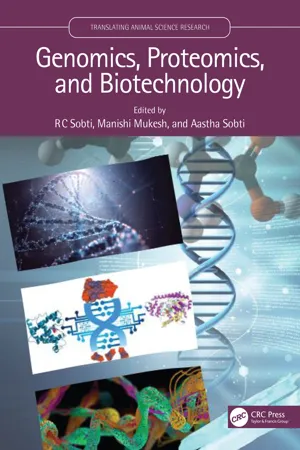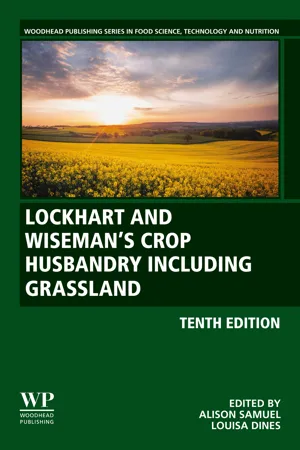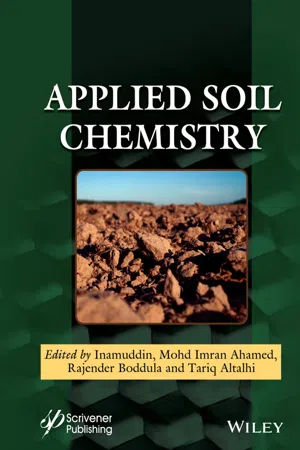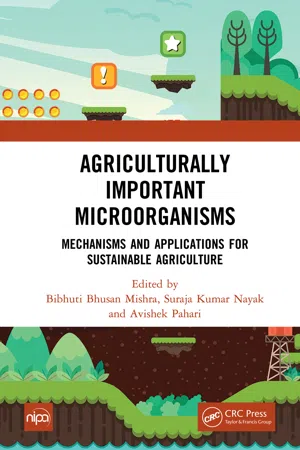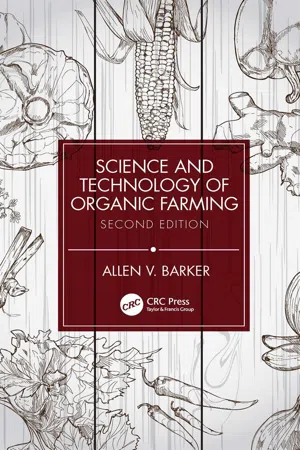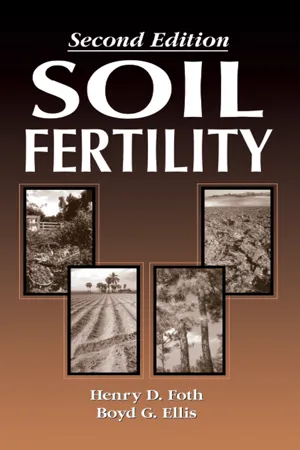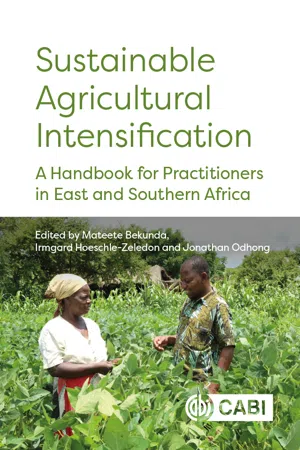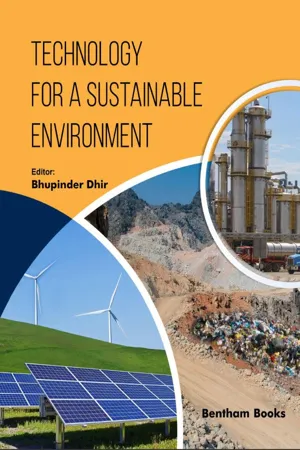Biological Sciences
Fertilisers
Fertilisers are substances added to soil or plants to provide essential nutrients for growth. They can be natural or synthetic and are commonly used in agriculture to improve crop yield and quality. Fertilisers typically contain nitrogen, phosphorus, and potassium, as well as other micronutrients necessary for plant development.
Written by Perlego with AI-assistance
Related key terms
10 Key excerpts on "Fertilisers"
- eBook - ePub
- RC Sobti, Manishi Mukesh, Aastha Sobti, RC Sobti, Manishi Mukesh, Aastha Sobti(Authors)
- 2022(Publication Date)
- CRC Press(Publisher)
Varying amounts of microbes in the soil form a vital component in biotic activities of the soil ecosystem, which makes them essential in nutrient mobilization and sustainability for the production of crops (Ahemad and Kibret, 2014). On the contrary, chemical fertilizers are not only expensive, they also disturb the equilibrium of agricultural ecosystems by causing a tremendous amount of pollution leading to an ecological imbalance in the environment. All of these problems can be avoided by the use of biofertilizers (Al-Khiat, 2006). The utilization of biofertilizers has immense advantages over the use of conventional chemical fertilizers in agriculture. Biofertilizers are safer than most of the chemical fertilizers currently in use. They are nontoxic and microorganisms are not accumulated in the food chain. They do not need repeated application in most of the known cases. In the case of biofertilizers as pest control or biocontrol agents, development of resistance against the microorganism is seldom noticed (Wu et al., 2005). Biofertilizers mainly include nitrogen-fixing, phosphate solubilizing, potassium mobilizing and plant growth-promoting microorganisms that fulfill the major NPK requirements of the plants and secrete growth hormones. Amongst the commonly used biofertilizers benefiting the crops are Azotobacter, Azospirillum, blue-green algae, Azolla, P-solubilizing microorganisms, mycorrhizae, and Rhizobium (Selvakumar et al., 2009). 19.3 ESSENTIAL SOIL NUTRIENTS FOR SUSTAINABLE AGRICULTURE The combined effect of physical factors such as the air, water, light, pH, micronutrients and macronutrients determines the overall yield of crops and growth of plants. The quality of soil progressively decreases due to continuously being used for crop production season after season and needs replenishment of the nutrients at the same or higher rate - Alison Samuel, Louisa Dines, Steve Finch, Gerry P. Lane(Authors)
- 2022(Publication Date)
- Woodhead Publishing(Publisher)
4: Fertilisers and manures
Abstract
This chapter explains the importance of optimising plant nutrition and soil fertility for crop production. It discusses the main plant food elements required by crops, both major nutrients and micronutrients (trace elements). It describes the fertiliser materials used on-farm and explains the differences between straights, compounds, complexes and blends, as well as considering application practices and methods for both solid and liquid Fertilisers. Organic materials, both produced on- and off-farm are valuable nutrient sources for crop production and can often be additionally beneficial as soil conditioning agents. Livestock manures and slurries, together with a range of other organic materials, are described in terms of their characteristics and best use. Finally, the chapter considers the effect of Fertilisers and manures on the wider environment.Keywords
Compound; Fertiliser; Nitrogen; Nutrient; Organic material; Phosphorus; Potassium; Straight4.1. Introduction
Good nutrient management is a key aspect of viable and sustainable agricultural production. There is the challenge of increasing food production for the growing global population whilst ensuring that environmental impacts are lessened. Supplying optimal levels of nutrients for crop and livestock production as part of profitable farming businesses involves extensive decision making associated with the importance of integrated farming systems and their connection with the wider environment including the abiotic considerations of soil, water and air linked to the biotic aspects of habitats, biodiversity and species.For viable field crop production, in terms of economic yield and good crop quality, nutrients should be readily available so that uptake is optimised and both nutrient deficits limiting uptake and nutrient excesses that may cause losses to the environment are reduced. Nutrient removals off the field as a result of crop harvest should be considered in nutrient budgeting calculations and decisions so that nutrient inputs help to reduce any nutrient gaps in the system and soil available nutrient levels are maintained at an optimum level that suit both effective cropping and a better environment. An assessment of nutrient budgeting considers at a basic level both crop nutrient supply and harvest offtake, but in more detailed assessments can include all nutrient additions to the soil supplying the crop and all nutrient outputs including to the wider environment away from the crop. It is important that any nutrient supply system minimises the loss of nutrients to the environment as well as avoiding either a deficiency or an excess of individual, required nutrient elements. There are additional factors associated with local soil characteristics, nutrient behaviour and effects of weather and climate that should also be part of any nutrient decision-making process.- Chhatarpal Singh, Shashank Tiwari, Jay Shankar Singh, Ajar Nath Yadav, Chhatarpal Singh, Shashank Tiwari, Jay Shankar Singh, Ajar Nath Yadav(Authors)
- 2020(Publication Date)
- CRC Press(Publisher)
Figure 4.2 . In the late 19th century, the first license for producing a biological fertilizer known as Nitragin was issued for the production of Rhizobium inoculants and after that, the inoculation of legumes started to be practiced in many countries using rhizobium fertilizers (Bagnasco et al. 1998). Liquid bio-fertilizers are special liquid formulations containing not only the desired microorganisms and their nutrients but also special cell protectants or chemicals that promote the formation of resting spores or cysts for longer shelf life and tolerance to adverse conditions.FIGURE 4.2 Multi-benefits of bio-fertilizers considered as nature’s greatest gift.4.2 Effects of Chemical Fertilizers and Pesticides on Soil and Human Health
In modern agriculture, due to the heavy usage of chemical fertilizers and harmful pesticides on the crops, the sustainability of the agriculture systems collapsed, so the cost of cultivation soared at a high rate, resulting in a stagnant income for farmers stagnated. Thus, food security and safety have become a daunting challenge. The indiscriminate and imbalanced use of chemical fertilizers, especially urea, along with chemical pesticides and the unavailability of organic manures, has led to a considerable reduction in soil health. This has a heavy impact on the natural environment, as well as on human health, through the pollution of soils, waters and the whole food supply chain (Mazid and Khan 2014). Agricultural chemical inputs gain access into human body systems through three major means: (i) oral ingestion, (ii) infiltration through the skin and (iii) breathing (Roychowdhury et al. 2014). Pesticides have shown long-term resistance in food including vegetables, meat and fruits and in the human body (Battu et al. 2005). Quite a number of people are negatively affected by long-term exposure to agrochemicals, even at low levels (Kirkhorn and Schenker 2001). The illnesses range from respiratory disorders and musculoskeletal illnesses to dermal and cardiac-related diseases. These illnesses are encountered by farm owners, operators, family members and employees (Magauzi et al. 2011). In developing countries where less than 20% of the world agrochemical production is consumed, agrochemicals have been reported to account for 70% of acute poisoning among the working population (United States Environmental Protection Agency [USEPA] 2016). For example, in Nigeria, Ojo (2016) observed the factors that intensify health hazards from pesticide use; the use of low-cost pesticides but which proved to be the deadliest types (in terms of persistence and toxicity); poor pesticide education leading to extensive misuse; pesticide residue on locally consumed products; poor legislation and lack of enforcement of available legislation; inadequate information, awareness and knowledge of the inherent dangers of pesticides and inadequacies in medical recognition; responses to pesticide poisoning and the failure of regulatory systems (Alori and Babalola 2018).- eBook - ePub
- Mohd Imran Ahamed, Rajender Boddula, Tariq Altalhi, Mohd Imran Ahamed, Rajender Boddula, Tariq A. Altalhi(Authors)
- 2021(Publication Date)
- Wiley-Scrivener(Publisher)
7 Fertilization and Fertilizer Typesİdris KaragözDepartment of Polymer Materials Engineering, Yalova University, Yalova, TurkeyAbstractNowadays, fertilizers are among the most important production factors of sustainable and modern agriculture. With the use of science, technical methods, and fertilizers with different contents in agriculture, the quality and quantity of agricultural products have increased significantly. In this study, it is aimed to compile information about fertilizers and to create a reference source for those working in the agricultural sector and those interested in the subject by using the literature information. In the study, the purpose of fertilization and its application methods were mentioned, and fertilizers were classified under two main headings: fertilizers containing organic matters and chemical fertilizers. In the use of fertilizers, conducting soil analysis, knowing the nutrients needed by the plant to be planted, the chemical composition of the fertilizer, climatic conditions such as temperature and precipitation, procedures previously applied to the soil, and conscious agriculture have been determined to be essential factors. It has been observed that plants planted in areas poor in terms of nutrients do not only affect plant development but also affect human and animal health with the consumption of these plants. In the future, it is predicted that chemical fertilizers will be used more than other types of fertilizers in agricultural production in order to grow more quality products in agriculture for the purpose of meeting the food need emerging in parallel to the increasing world population.Keywords: Fertilizers, fertilization, agricultural, plant, sustainability, nutrient, chemical7.1 Introduction
The ability of plants to make organic matters from inorganic matters has enabled plants and plant products to be the basic nutrients of humans and animals from past to present [1]. Scientific studies on the healthy nutrition of plants and increasing product efficiency have been conducted for long years. It has been proven by scientific studies that humans and animals who have to be fed with unhealthy and undernourished plants and plant products obtained from them suffer from different diseases due to vitamin and mineral deficiencies [1–3]. - eBook - ePub
Agriculturally Important Microorganisms
Mechanisms and Applications for Sustainable Agriculture
- Bibhuti Bhusan Mishra, Suraja Kumar Nayak, Avishek Pahari, Bibhuti Bhusan Mishra, Suraja Kumar Nayak, Avishek Pahari(Authors)
- 2021(Publication Date)
- CRC Press(Publisher)
3Role of Biofertilizer in Sustainable Agriculture: Enhancing Soil Fertility Plant Tolerance and Crop Productivity
Priyanka Verma1 * , Dheer Singh2 , Ishwar Prasad Pathania3 and Komal Aggarwal4Department of Microbiology, Eternal University, Sirmaur-173101, India1Department of Microbiology, Bundelkhand University, Jhansi-284128, India2Department of Biotechnology, Sharda University, Greater Noida-201306, India34Department of Biotechnology, Gautam Buddha University Greater Noida-201310, IndiaAbstract
Agriculture is one of the most important factors contributing to the economic growth of India. Out of the 329 million hectares of India’s geographical area, about 114 million hectares are under cultivation. There are 17 essential elements required for proper plant growth. Of the mineral elements, the primary macronutrients (nitrogen, phosphorous, and potassium) are needed in the greatest quantities and are most likely to be in short supply in agricultural soils. Secondary macronutrients are needed in smaller quantities, and are typically found in sufficient quantities in agricultural soil, and therefore do not often limit crop growth. Micronutrients, or trace nutrients, are needed in very small amounts and can be toxic to plants in excess. Silicon (Si) and sodium (Na) are sometimes considered essential plant nutrients, due to their ubiquitous presence in soils.The economy of India thrives on agriculture, the most practiced occupation in the country. Agricultural fertilizers are essential to enhance proper growth of plants and crop yield. Recently, farmers have been using chemical fertilizers for quicker and better yield. But these fertilizers endanger ecosystems, soil, plants, human and animal lives. In contrast, naturally grown biofertilizers not only give a better yield, but are also harmless to humans. This chapter aims to study the biofertilizers play a key role for enhancing economic development of sustainable agriculture (EDSA) in - eBook - ePub
- Shah Fahad, Shah Saud, Fazli Wahid, Muhammad Adnan, Shah Fahad, Shah Saud, Fazli Wahid, Muhammad Adnan(Authors)
- 2023(Publication Date)
- CRC Press(Publisher)
8.6.5 Extension and Market Constraints8.6.6 Farmer Awareness8.7 Future Prospects for Biofertilizers- References
8.1 Introduction
The agriculture sector plays an important role in improving the standard of living in a country. Hence, it is necessary to ensure food security and access for the global population. The agriculture sector has experienced a massive change (Ajmal et al. 2016). Today, the agriculture sector not only improves food supply but also improves the living standard of all. To fulfil this demand, farmers have used an excessive amount of agrochemicals to enhance crop growth and productivity (Aktar et al. 2009 ; Santos et al. 2012 ). Agrochemicals are synthetic products that contain essential elements, e.g. nitrogen, potassium, and phosphorus. Nowadays, to increase soil fertility, farmers mostly use synthetic fertilizers, which cause numerous environmental issues, e.g. health problems, air, soil, and water pollution, climate change, loss of beneficial biodiversity, etc. In long term, they may destroy soil fertility (Bhardwaj et al. 2014 ; Khan et al. 2016 ). According to Chun-Li (2014) , agrochemical applications increase soil acidity and result in environmental pollution, with plants also becoming susceptible to many diseases (Khosro and Yousef 2012 ). Researchers have developed a new approach in the formulation of biofertilizers, which keep the soil rich in all nutrients and protect the soil from pollution.Biofertilizers are the most essential part of integrated nutrients management that play a vital role in productivity and soil sustainability when added to soil. Biofertilizers do not supply nutrients directly to the plant, they use strains of efficient beneficial microbes added to soil, seeds, and compost to accelerate the process and to enhance nutrient availability to plants that help in plant growth (Yadav and Sarkar 2019 ). Biofertilizers include nitrogen-fixing bacteria (Rhizobium, Azospirillum, cyanobacteria, Clostridium, azotobacter, and Bacillus polymyxin), phosphate-solubilizing bacteria (Aspergillus, Bacillus, Fusarium, etc.), potassium-solubilizing bacteria (Bacillus edaphicus, Bacillus mucilagenosus), sulphur-solubilizing bacteria (chemolithotrophs, Thiobacillus denitrificans, etc.) and arbuscular mycorrhiza (Gautam et al. 2021 ). These microbes are used in different combinations for the preparation of biofertilizer formulations for enhancing crop productivity. Biofertilizers are an eco-friendly approach that help to enhance soil fertility, sustainability, and plant growth and productivity (Mohapatra et al. 2013). The above-mentioned aspects aid farmer incomes through a noticeable reduction in the cost of agrochemicals (Fundases 2005 ). Biofertilizer application can be a feasible option with many social, economic, and environmental benefits (Carvajal-Munoz and Carmona-García 2012). However, biofertilizer implementation needs more practice, studies of environmental variables, assets, and time in research (Vanegas 2003 ; Fresco 2003 - eBook - ePub
- Allen V. Barker(Author)
- 2021(Publication Date)
- CRC Press(Publisher)
Growers may find it practical to use a balanced approach in uses of organic and chemical fertilizers. Organic fertilizers may be used for building soil fertility over a long period of time. Initially, growers may rely on supplemental use of chemical fertilizers with organic fertilizers in poor soils. As the fertility with respect to nutrient supply increases with prolonged application of organic materials, use of chemical fertilizers may be tapered off. A grower may use chemical fertilizers in the making of organic fertilizers. Chemical nitrogen fertilizers often are added to compost piles to accelerate the rate of decomposition of organic matter. Chemical phosphate fertilizers also are added to composts and to farm manures to fortify the phosphorus concentrations of these otherwise phosphorus-poor materials. Certified organic growers, however, have limitations on the use of chemical fertilizers in crop production. Certifying organizations require a time period of 3 years between the discontinued use of chemical fertilizers and issuance of certification as an organic grower. Before transition to organic farming, farmers may want to provide liberal applications of chemical fertilizers to raise the nutrient contents of soils.Analyses of Fertilizers
Fertilizers that are sold commercially, whether organic or chemical, are labeled for their nutrient contents. The analysis of a fertilizer is a term that is synonymous with grade of fertilizer. The analysis or grade is expressed by three numbers that indicate the amount of nitrogen, phosphorus, and potassium in the fertilizer. The label on the fertilizer container reports the analysis as available nitrogen (N), available phosphoric acid (P2 O5 ), and available potash (K2 O). Note that only the nitrogen is reported on an elemental basis. The units of P2 O5 and K2 O are only quantitative terms as P2 O5 and K2 O do not exist as such in the fertilizers. The expressions of elements quantitatively as oxides are derived from units used in the historical presentation elemental analysis. Soil tests and recommendations for fertilization of crops are coordinated with these chemical expressions of nutrient content. The term available - eBook - ePub
- Boyd Ellis, Henry Foth(Authors)
- 2018(Publication Date)
- CRC Press(Publisher)
14 Application and Use of FertilizersIn general, about 50% of the N, 20% of the P, and 35% of the K, or less, in fertilizers is absorbed by crops during the year of application. Achieving the maximum biological efficiency in using fertilizers depends on time of application and their placement. Factors that influence decisions about when to apply a fertilizer and where to place it include nutrient mobility and fixation in the soil; plant needs and the location of roots; losses by volatilization and leaching; the amount of soil moisture and temperature of soils; and salt effects on germination. In general, the closer the time of application matches plant nutrient demands, decreases the opportunity for fixation and loss, and increases the opportunity for absorption and a yield response to the nutrient applied. Rates of application and use are also affected by economic and environmental considerations and convenience.14.1 FERTILIZER APPLICATION PRACTICESFertilizers are placed either on or in the soil. The major methods of surface placement are broadcast of dry materials, spraying of liquids, and application in irrigation water. Methods of placing fertilizer in the soil includes band placement, plow down, injection, and application in irrigation water. Only a very minor amount of fertilizer is applied to leaves as a foliar spray.Fertilizer placement and time of application are importantly affected by the practices used to establish and manage a crop and the properties of soils and fertilizers. In general, dry and liquid forms are of equal value if similarly placed in the soil and applied at the same period of time. The major factor is amount of nutrient applied. Nutrients from both dry and liquid forms must appear in the soil solution as ions before they can be taken up by plants. As the level of soil fertility increases, placement of fertilizer becomes less important. - eBook - ePub
Sustainable Agricultural Intensification
A Handbook for Practitioners in East and Southern Africa
- Mateete Bekunda, Jonathan Odhong, Irmgard Hoeschle-Zeledon(Authors)
- 2022(Publication Date)
- CAB International(Publisher)
The yield of a plant is limited by a deficiency of any one essential element, even when all others are present in adequate amounts. In this illustration, too little nitrogen is the main problem. If nitrogen is added up to the top, phosphorus becomes the next limiting nutrient. Adapted from Whitson and Walster (1912). Before making a decision about which fertilizers to apply, it is important to test the soil and identify which nutrients are lacking. The soils in Babati are of moderate fertility with deficiencies in nitrogen, phosphorus, and, in some locations, low levels of zinc. Soils in Kongwa and Kiteto are heavily eroded and of poor fertility, with widespread deficiencies in nitrogen, phosphorus, sulfur, zinc, and boron. Soils in Machinga and Dedza in Malawi are deficient mostly in nitrogen, sulfur, and zinc. Industrial fertilizers Description of the technology Industrial fertilizers consist of inorganic or synthetically produced organic compounds containing nutrients for plant use. Organic compounds such as phosphate rocks that are further enriched with inorganic compounds are also considered as industrial fertilizers in the context of this chapter. These fertilizers are applied at planting, with nitrogen-containing fertilizers often used for additional top-dressing. The most common nutrients supplied in fertilizers are nitrogen, which promotes the growth of the plant, and phosphorus, which improves root growth and flowering. There are many types of industrial fertilizers; some contain one nutrient (straight fertilizers) while others contain two or more nutrients (compound fertilizers). Africa RISING tested and validated the following types of fertilizers: • Diammonium phosphate (DAP): Contains 18% nitrogen, 46% phosphate, and 1.6% sulfur. DAP is the world’s most widely used phosphate fertilizer. It is popular because of its relatively high nutrient content and because it is water soluble. It temporarily increases soil acidity, but over time reduces it - eBook - ePub
- Bhu pinder Dhir(Author)
- 2000(Publication Date)
- Bentham Science Publishers(Publisher)
Modern agriculture is almost entirely reliant on the supply and utilization of agrochemicals, such as fertilizers, pesticides, and insecticides, to maintain and boost agriculture productivity. Heavy use of chemical fertilizers has resulted in numerous adverse effects on the environment and human health. Biofertilizers have emerged as an eco-friendly, inexpensive, and renewable alternative to restore, enhance, and maintain soil fertility, soil health, and crop yield. Biofertilizers are beneficial microbes, including plant growth-promoting rhizobacteria, mycorrhizal fungi, cyanobacteria, and their symbionts. Hence, the importance of biofertilizers in soil management practices for soil and crop sustainability needs to be highlighted in light of their multiple benefits, including augmenting nutrient availability in the rhizosphere, increasing nutrient uptake and recycling, supplementing soil water holding capacity, production of plant growth regulators, and soil reclamation. The challenges regarding the large-scale utilization of biofertilizers need to be emphasized to achieve sustainability in agricultural soils.Keywords: Biofertilizers, Biotechnology, Nutrient, Phosphorus, Soil he, Sustainable agriculture.* Corresponding author Ruby Tiwari: Department of Genetics, University of Delhi, South Campus, New Delhi, 110021, India; E-mail: [email protected]INTRODUCTION
Currently, the global population is still increasing and it is estimated that around 2050 it will reach approximately 9.7 billion people in the world [1 ].With the increasing human population, food demand grows exponentially, and to cope with this problem, we have major challenges like maintaining sustainable agriculture to create a balance in the ecosystem. The unconscious application of agrochemicals and lack of knowledge regarding biodegradation ability lead to soil chelation with toxic molecules, which disturbs the soil structure, fertility, and water-holding capacity [2 ]. Over usage of synthetic fertilizers has been directly linked to the eutrophication of water resources [3 - 5 ] and the toxic build-up of heavy metalssuch as arsenic, cadmium, and plumbum [6 ]. The rapid growth in the world population has been the key factor in the explosion of intensive industrialization, urbanization, and agricultural production. The nutritional requirements of the present world population cannot be achieved by traditional agriculture practices, and these methods are incapable of making the countries self-sufficient [7 - 9 ]. Conventional agricultural practices based on the extensive application of synthetic fertilizers and pesticides are applied to enhance crop productivity and make the crop disease resistant [10 ]. Unfortunately, both these methods directly or indirectly consist of a high risk to the environment as they expose the water table, air, and soil stratum to these toxic chemicals [11 ]. The unconscious application of agrochemicals and lack of knowledge regarding biodegradation ability lead to soil chelation with toxic molecules, which disturbs the soil structure, fertility, and water-holding capacity [2 ]. Over usage of synthetic fertilizers has been directly linked to the eutrophication of water resources [3 - 5 ] and the toxic build-up of heavy metals such as arsenic, cadmium, and plumbum [6 ]. The rapid growth in the world population has been the key factor in the explosion of intensive industrialization, urbanization, and agricultural production. The nutritional requirements of the present world population cannot be achieved by traditional agriculture practices, and these methods are incapable of making the countries self-sufficient [7 - 9 ]. Conventional agricultural practices based on the extensive application of synthetic fertilizers and pesticides are applied to enhance crop productivity and make the crop disease resistant [10 ]. Unfortunately, both these methods directly or indirectly consist of a high risk to the environment as they expose the water table, air, and soil stratum to these toxic chemicals [11
Learn about this page
Index pages curate the most relevant extracts from our library of academic textbooks. They’ve been created using an in-house natural language model (NLM), each adding context and meaning to key research topics.
